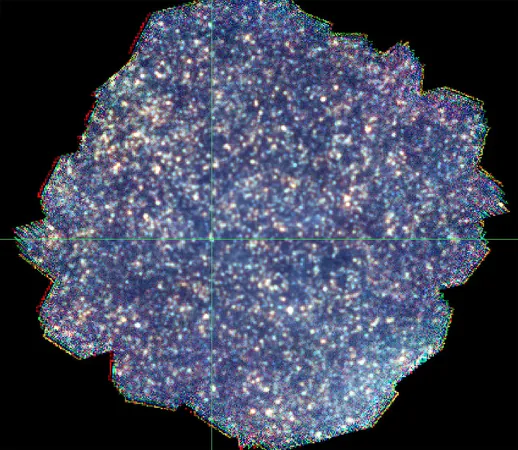
Unveiling the Universe: The Shocking Discovery of 'Hidden Galaxies' Could Change Everything!
2025-04-10
Author: Jessica Wong
A Cosmic Revelation in Deep Field Imaging
Astrophysicists have made an exhilarating discovery that could revolutionize our understanding of the universe! Newly analyzed deep-field images, compiled from a montage of infrared observations, suggest the existence of elusive cosmic structures known as 'hidden galaxies.' These dust-filled star systems could be the key to unraveling mysteries that have puzzled astronomers for ages!
Mapping the Invisible: Nearly 2,000 Galaxies Revealed
In a groundbreaking study, researchers utilized state-of-the-art imaging techniques to unveil nearly 2,000 galaxies in a far-infrared landscape. Preliminary findings indicate that there may be even more galaxies on the fringes of visibility, potentially altering our comprehension of energy distribution throughout the cosmos.
Why Infrared Observations Matter
Exploring the universe through infrared light allows scientists to detect objects that remain veiled to optical telescopes. This spectrum unveils cooler regions where dust emits energy in wavelengths beyond human sight. Such observations have opened new windows into stellar nurseries and galactic cores, unveiling phenomena hidden from traditional views.
The Herschel-SPIRE Dark Field: A Game Changer
Leading the charge in this research is Dr. Chris Pearson from STFC RAL Space and Imperial College London. He emphasizes that this study pushes the boundaries of Herschel's scientific capacity, potentially revealing a brand new population of galaxies that contribute to the faintest lights in the universe. The Herschel-SPIRE Dark Field offers the most detailed far-infrared view ever captured, assembled from 141 images taken by the Herschel Space Observatory.
Challenging Existing Models of Galaxy Evolution
These initial results are igniting curiosity among experts. Discussions suggest that these hidden galaxies could fill gaps in our understanding of energy generation at long infrared wavelengths, challenging established theories related to galaxy formation and evolution.
The Quest for the Unknown: Statistical Insights
Thomas Varnish, a PhD candidate at MIT, employed advanced statistical methods to analyze the obscure regions of the images. His research hints at a potential new, undiscovered population of faint galaxies that classic detection methods failed to identify. If proven, this finding could drastically shift our models of the universe.
Peering Beyond the Dust: Understanding Cosmic Activity
Experts stress the importance of infrared observations, revealing that about half of cosmic activities remain obscured by dust. The energy emitted from this hidden universe contributes significantly to the cosmic energy budget, emphasizing the need for a dual approach in studying the universe: through both optical and longer-wavelength infrared light.
What Lies Ahead in Cosmic Discovery
Dr. David Clements from Imperial College London highlights the invaluable data still emerging from the Herschel archive, even a decade after its operations ceased. While the James Webb Space Telescope now leads in infrared astronomy, it lacks the far-infrared sensitivity that Herschel provided. To chase after these intriguing discoveries, a new mission named PRIMA is proposed, aiming to unlock even deeper cosmic secrets.
The Implications of Hidden Galaxies on Cosmic Understanding
To wrap it up, the potential existence of hidden galaxies transforms our conception of the universe. The findings from the Herschel-SPIRE Dark Field suggest we are merely scratching the surface of cosmic knowledge. With groundbreaking missions like PRIMA on the horizon, the universe’s secrets are bound to unravel further, revealing how these obscured galaxies shape cosmic evolution. The search for the truths hidden in the dust continues!




 Brasil (PT)
Brasil (PT)
 Canada (EN)
Canada (EN)
 Chile (ES)
Chile (ES)
 Česko (CS)
Česko (CS)
 대한민국 (KO)
대한민국 (KO)
 España (ES)
España (ES)
 France (FR)
France (FR)
 Hong Kong (EN)
Hong Kong (EN)
 Italia (IT)
Italia (IT)
 日本 (JA)
日本 (JA)
 Magyarország (HU)
Magyarország (HU)
 Norge (NO)
Norge (NO)
 Polska (PL)
Polska (PL)
 Schweiz (DE)
Schweiz (DE)
 Singapore (EN)
Singapore (EN)
 Sverige (SV)
Sverige (SV)
 Suomi (FI)
Suomi (FI)
 Türkiye (TR)
Türkiye (TR)
 الإمارات العربية المتحدة (AR)
الإمارات العربية المتحدة (AR)